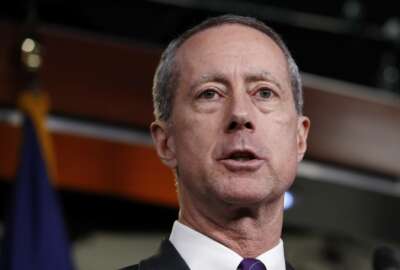
DISA saved from congressional scalpel, for now
The House Armed Services Committee is pulling back its recommendation to eliminate seven DoD agencies.
The Defense Information Systems Agency, the Defense Human Resources Activity and four other Defense Department agencies are ducking Congress’ guillotine, for now.
The House Armed Services Committee’s final draft of the 2019 defense authorization bill is pulling back from its original plan to eliminate seven agencies from DoD in hopes of consolidating tasks and finding efficiencies by cutting the Fourth Estate.
The Fourth Estate refers to 28 agencies that are not part of a military service and employ 200,000 civilian personnel and nearly 600,000 contractors.
After hearing from experts and lawmakers, the House version of the bill will only kill off the Washington Headquarters Services (WHS), the organization in charge of providing services to the Pentagon, DoD agencies and the National Capital Region.
“Based on the reviews that we’ve done, based on when WHS was established you’re basically talking about the bureaucracy for the bureaucracy,” a House Armed Services Committee staffer said.
The staffer added WHS was created to concentrate personnel functions; however, that mission is now diluted.
“The Army still maintains its personnelists, they nominate [a senior executive service (SES) member], the run the SES through the Washington Headquarters Service, they run that through the Office of Personnel Management. Is that middleman adding any capability? Or is it, in fact, simply reducing the efficiency and the speed in which the department can bring on a senior executive to help manage, for example, helping to recover technological superiority on hypersonics,” the staffer said.
That doesn’t mean the other six agencies, which include the Defense Technical Information Center, the Office of Economic Adjustment, the Test Resource Management Center, the Defense Technology Security Administration, in addition to DISA and DHRA are getting off scot-free.
The committee asked the DoD chief management officer to justify keeping each agency.
The bill also still holds a provision to cut 25 percent from the Fourth Estate by 2021, another task that will go to the CMO.
The 25 percent cut will be only from logistics, human resources, contracting and real property management. Healthcare and IT are exempt from the cuts because DoD already has initiatives to make them more cost effective.
The bill gives the CMO discretion over how and where those cuts will be made.
“I’m going to make somebody in charge of this Fourth Estate, which is the new chief management officer who we created a couple years ago, and I’m going to expect him to find 25 percent savings over the next two years. If he doesn’t find it, we are going to do it for him,” House Armed Services Committee Chairman Mac Thornberry (R-Texas) said during an April 17 meeting with reporters.
The intelligence community agencies are exempt from the cuts.
A handful of concerns about the committee’s original plan to get rid of seven agencies and place responsibility on the CMO still remain in the bill.
Former DoD deputy chief management officer Peter Levine expressed concerns about the chief management officer’s ability to manage all of the agencies that would come to fall under his jurisdiction, during an April 18 House Armed Services Committee hearing.
“My concern with the CMO being the direct line of authority over the defense agencies is that that could overwhelm the individual and all of a sudden that time CMO has to develop management initiatives that cut across the department, you no longer have that time and ability,” Levine said.
He added a second concern that since the CMO office is so new it may not have the institutional capability yet to manage so many agencies while also building a new bureaucracy.
As far as the WHS goes, Levine said everyone loves to criticize Pentagon headquarters staff and functions, but agencies like the Washington Headquarters Services provide essential functions like facilities, acquisition, financial and human resources functions for the Pentagon.
House Armed Services Committee Ranking Member Adam Smith (D-Wash.) had similar concerns.
“It appears this proposal could do serious damage to DoD’s information infrastructure, testing ranges, and community support, as well as the basic DoD functions in the National Capital Region by eliminating critical agencies in one stroke,” Smith said in an April 18 statement. “Those are important functions that I don’t think we should discard if we haven’t done careful study and analysis. It’s also important that we consider the impact on our men and women in uniforms’ ability to do their jobs and their quality of life, as well as on thousands of jobs across the country.”
Copyright © 2024 Federal News Network. All rights reserved. This website is not intended for users located within the European Economic Area.
Scott Maucione is a defense reporter for Federal News Network and reports on human capital, workforce and the Defense Department at-large.
Follow @smaucioneWFED
Related Stories






